

Search Results. Matariki. Image: The Pleiades (Messier 45) revisited by Fred Locklear on Flickr We have selected these resources to support you when you need information relating toMatariki, the Māori celebration of New Year, the Seven Sisters, Pleiades, constellations, and Māori gardening.
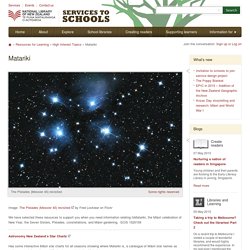
SCIS 1525159 Astronomy New Zealand’s Star Charts Has some interactive Māori star charts for all seasons showing where Matariki is, a catalogue of Māori star names as well as some information on Māori astronomy including Matariki. Suggested level: intermediate, DigitalNZ This site provides to thousands of pictures, video, sounds, and objects from New Zealand museums, libraries, galleries, archives, and private institutions. Suggested level: primary, intermediatewww.digitalnz.org/user_sets/547cea608d2a4e1455000001 ManyAnswers To discover information on the school work site ManyAnswers use the search term Matariki. Matariki — the Aotearoa / Pacific New Year. The rise of the star cluster Matariki marks the beginning of the Aotearoa Pacific New Year according to the lunar calendar.
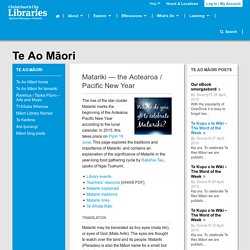
In 2015, this takes place on Pipiri 18 June. This page explores the traditions and importance of Matariki, and contains an explanation of the significance of Matariki in the year-long food gathering cycle by Rakiihia Tau, upoko of Ngai Tuahuriri. Translation Matariki may be translated as tiny eyes (mata riki), or eyes of God (Mata Ariki). The eyes are thought to watch over the land and its people.
Celebrations Matariki tribal celebrations are held at different times by different tribes. Cultural significance The Māori often turned factual information into entertaining tales — it made things easy to remember. There are many stories about its cultural significance as a navigational star and also as an indication of bountiful harvests. The reappearance signifies a time to prepare, to share ideas, to remember the past and celebrate the future.
Matariki signals growth. Matariki Education Resource. Raise your students’ awareness of Matariki!
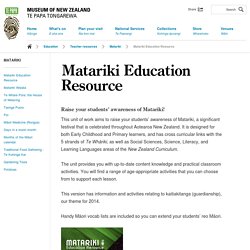
This unit of work aims to raise your students’ awareness of Matariki, a significant festival that is celebrated throughout Aotearoa New Zealand. It is designed for both Early Childhood and Primary learners, and has cross curricular links with the 5 strands of Te Whāriki, as well as Social Sciences, Science, Literacy, and Learning Languages areas of the New Zealand Curriculum.
The unit provides you with up-to-date content knowledge and practical classroom activities. You will find a range of age-appropriate activities that you can choose from to support each lesson. This version has information and activities relating to kaitiakitanga (guardianship), our theme for 2014. Handy Māori vocab lists are included so you can extend your students’ reo Māori. Download the Matariki education resource 2014 (PDF, 1.42MB) Tangohia mai i nga rauemi ako mo Matariki (PDF, 1.91MB) New Zealand. June - July 2015 Nationwide Matariki is the Māori name for the small cluster of stars in the Taurus constellation that rise during the New Zealand winter.
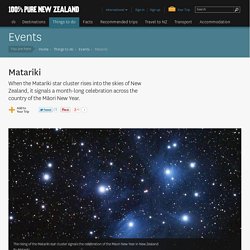
Matariki has always been an important time in the Māori calendar. For early Māori, Matariki was strongly connected to the seasons and was an indicator of the forthcoming year. Matariki means ‘eyes of the god’ or ‘little eyes’. Some say that when Ranginui, the sky father, and Papatūānuku, the earth mother, were separated by their children, the god of the winds, Tāwhirimātea, became angry, tearing out his eyes and hurling them into the heavens. The Māori New Year signals a time for connecting with, and giving thanks to, the land, sea and sky. Matariki - Te Taura Whiri i te Reo Māori - Māori Language Commission. The beginning of the Māori calendar is Matariki – the indigenous, Aotearoa, New Year.
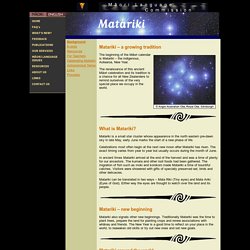
The renaissance of this ancient Māori celebration and its tradition is a chance for all New Zealanders to remind ourselves of the very special place we occupy in the world. Matariki is a small star cluster whose appearance in the north eastern pre-dawn sky in late May, early June marks the start of a new phase of life. Celebrations most often begin at the next new moon after Matariki has risen. The exact timing varies from year to year but usually occurs during the month of June. In ancient times Matariki arrived at the end of the harvest and was a time of plenty for our ancestors.
Matariki can be translated in two ways – Mata Riki (Tiny eyes) and Mata Ariki (Eyes of God). Matariki for schools - Matariki. For many New Zealanders, 31 December means parties and celebrations to welcome the New Year.
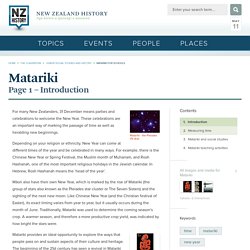
These celebrations are an important way of marking the passage of time as well as heralding new beginnings. Depending on your religion or ethnicity, New Year can come at different times of the year and be celebrated in many ways. Ministry for Culture and Heritage. Matariki – Māori New Year. What is Matariki?
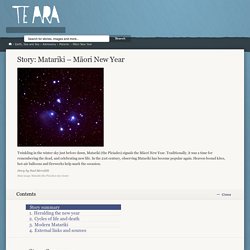
Matariki is the Māori name for the cluster of stars also known as the Pleiades. It rises in mid-winter – late May or early June.